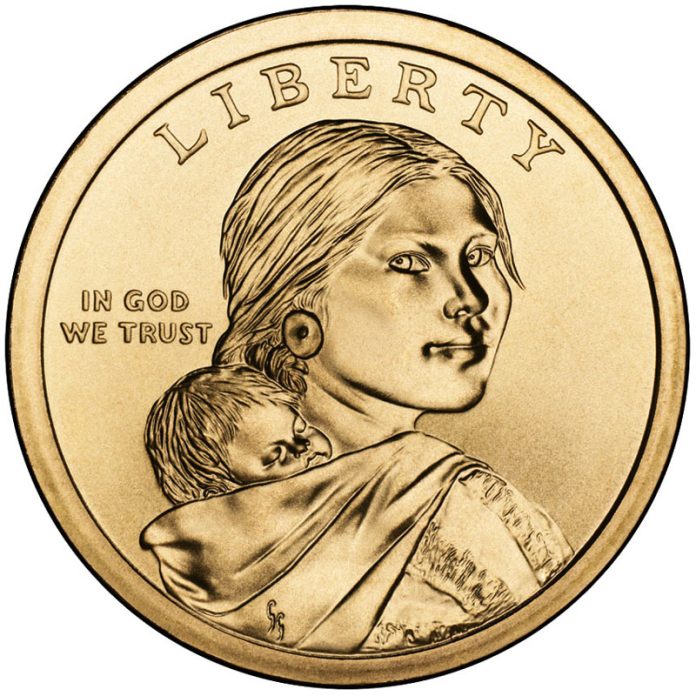
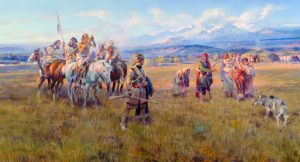
GETTY IMAGES / JPRASNGKH TA KHA / EYEEM
Bird Woman
This much we know. A teenaged Lemhi Shoshone girl, known as Sacagawea (‘Bird Woman’), guided Lewis and Clark on the chartered Corps of Discovery expedition from North Dakota to the Pacific Ocean. She was born in the spring of 1788 into the Agaidika ‘Salmon Eater’ people and at age 12, taken captive during a raid by a Hidatsa hunting party. Conflicting accounts say she was then purchased outright, or won through gambling by Toussaint Charbonneau, a Quebecois fur trapper. A year later, Sacagawea was his wife and, by 1804, expecting their first child.
Lewis and Clark had just parted ways at Fort Mandan in North Dakota with their original translator when they met and recruited Charbonneau, whose command of French and Hidatsa was helpful, but whose Shoshonefluent wives, Sacagawea and Otter Woman, were the true assets.
In a November 1804 journal entry, Clark wrote, “A french man by Name Chabonah, who speaks the Big Belley language, visit us, he wished to hire and informed us his 2 Squars were Snake Indians, we engau [engaged] him to go on with us and take one of his wives to interpret the Snake language…”
Joining Lewis & Clark
Sacagawea and Charbonneau joined Lewis and Clark in November 1804 at Fort Mandan where, on February 11, 1805, she delivered a son, Jean Baptiste. Clark, who called her ‘Janey,’ nicknamed the boy ‘Pomp.’
With a newborn slung over her shoulders, Sacagawea not only met but exceeded the explorers’ expectations. In May, Charbonneau, whom Clark called “a man of no peculiar merit,” nearly capsized the boat containing the expedition’s most valuable equipment, maps and papers. While an irate Lewis berated the trapper as “perhaps the most timid waterman in the world,” it was Sacagawea who rescued the precious contents of the pirogue from sinking or floating away. When the Corps sought fresh horses from the Shoshone that August before their trek over the Rocky Mountains, she led a successful and emotionally charged exchange with what proved to be her own lost brother, now Chief Cameahwait.
“The meeting of those people was really affecting,” Lewis entered in his 1805 journal. “Particularly between Sah cah-gar-we-ah and a woman taken prisoner at the same time with her. She made signs to me that they were her nation…”
Mint Marks & MoreThree mints produced Sacagawea and Native American Gold Dollars: Philadelphia (P), Denver (D) and San Francisco (S: proof coins only). Finding the marks is trickier. Sacagawea Golden Dollars (2000-2008) have the mark on the obverse just below the date. Native American Dollars (2009 to now) have the mark on the coin edge after the date. Sacagawea dollars are mostly F.V. (face value). An original 2000 P (uncirculated) is worth $1.50. Among those currently offering (uncirc) above F.V.: 2006 D – $7.00 |
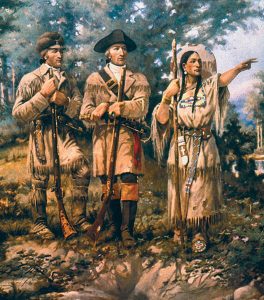
History and Mystery
Sacagawea’s final contribution before Lewis and Clark’s expedition concluded in July 1806 was to guide their return through the Rocky Mountains of Montana via Gibbons Pass and Bozeman Pass, the latter destined to become integral to the transcontinental railroad route of the Northern Pacific Railway and crossing of the Continental Divide.
Clark noted, “The wife of Shabono our interpreter we find reconciles all the Indians as to our friendly intentions, a woman with a party of men is a token of peace [and] confirmed people of our friendly intentions, as no woman ever accompanies a war party of Indians in this quarter [sic].”[6]She was an unexpected presence on an exceptional expedition. But the rest of the story about the woman on the coin grows as murky as the headwaters of the Missouri.
In her 2010 look at the life and death of Sacagawea, Native Americans: The True Story of Sacajawea and Her People, Bonnie Butterfield cites an 1812 entry by Fort Lisa (North Dakota) Trading Post clerk John Luttig that “the wife of Charbonneau, a Snake Squaw, died of putrid fever (epidemic typhus),” but Sacagawea is not identified by name and the trapper kept more than one wife. In a later recorded document among Clark’s original 1825-26 notes, he wrote, “Se car ja we au—Dead.”[7]Meanwhile, native oral tradition says Sacagawea left her abusive husband, crossed the Great Plains, and married into the Comanche nation before returning to Wyoming and her Shoshone nation in 1860, and dying there in 1884, where a modest headstone stands white in the moonlight of the 2.2 million acres of Wind River Reservation.
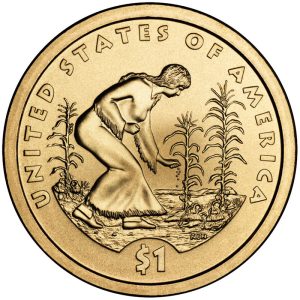 Sacagawea Dollars: Rare & Common
Sacagawea Dollars: Rare & Common
The Sacagawea dollar struck by the U.S. Mint to commemorate her service to the Lewis and Clark Expedition includes a coveted rare edition dollar distributed in boxes of Cheerios cereal, and while “undated” editions have sold on eBay for nearly $35,000, by 2009 the coin’s date was moved discreetly to the side, thus dashing many a naïve hope of fast fortune.
“Knowing Sacagawea dollar key dates, rarities and varieties will teach you to recognize that minor differences on a coin can mean significant differences in value,” cited James Bucki, in a June 2022 update to his Sacagawea Dollar Key Dates, Rarities and Varieties on TheSpruce-Crafts.com. From 2002 through 2008, Sacagawea dollars were minted only for collectors.
Production of the Sacagawea dollar by the U.S. Mint began in 1999 — 5,500 were produced by September of that year — but all were dated with a 2000-P obverse. Having learned a lesson or two from the public’s lackluster reception to its earlier (1979-1981) Susan B. Anthony dollar, the Mint partnered with commercially successful businesses like General Mills, Inc., to promote and launch a treasure hunt for newly minted “Golden Dollars” inside one of every 2000 specially marked boxes of Cheerios (10 million boxes were produced).
It wasn’t until 2005 that a keen-eyed coin collector, Pat Braddick, noticed how a prototype reverse used to produce the cereal box dollar had a distinct variance in the clarity and crispness of its eagle tail feathers. As of 2022, no more than 70 Sacagawea Cereal Box Dollars have appeared, putting their uncirculated value (depending on grade) at about $3000. Not bad for a $3 investment on a grocery list.
Sweetening the Chase
Further sweetening the collector’s chase, according to writer Susan Headley, a TPGS (Third Party Grading Service) opened a sealed box of Cheerios containing an original bonus dollar years earlier and found a regular, not flawed coin. “Therefore,” she wrote, “it is impossible to know exactly how many boxes of Cheerios contained a Sacajawea Dollar with the enhanced tail feathers.”
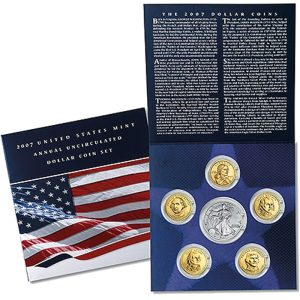 An official statement, issued June 17, 2007, from the U.S. Mint outlined, “5,500 Golden Dollars of a ‘high detail’ feather variety (12 tail feathers) were manufactured and shipped to General Mills as part of the Golden Dollar promotion in October 1999, under a detailed arrangement that they not be released until January 2000.”
An official statement, issued June 17, 2007, from the U.S. Mint outlined, “5,500 Golden Dollars of a ‘high detail’ feather variety (12 tail feathers) were manufactured and shipped to General Mills as part of the Golden Dollar promotion in October 1999, under a detailed arrangement that they not be released until January 2000.”
The statement continued, “Before the coins were released to the Federal Reserve in 2000, the feather detail was softened, and the center tail feather was recessed to solve a die manufacturing issue. Recessing the center tail feather gives the illusion of a 13th feather, but that was not the intent.”8
The Golden Dollar eagle faced another die flaw, the 2000-P Wounded Eagle, when three inexplicable raised die flaws seemed to pierce its torso and left wing. Fewer than 200 specimens are known to exist (unscrupulous dealers have been known to tool lines into a coin to simulate the flaw).
By 2007, the U.S. Mint was beginning to incuse the date, mint marks, and motto on the edges of its Presidential Dollars but not yet on this dollar. Or so it was thought. Somehow a 2007 Sacagawea Golden Dollar received edge lettering intended for Presidential Dollars (edge lettering was not used on the Sacagawea dollar, soon to be known as the Native American Dollar, until 2009). Since edge lettering can easily be added, seek authentication before purchasing a purported 2007 Sacagawea Dollar With Edge Lettering.
Sacagawea Dollar Edge Lettering & More…
Edge lettering (and a name change) came in 2008 with the Native American $1 Coin Act, dictating memorialization of the “important contributions made by individual tribes and individual Native Americans to the development of the United States,” with the year of minting, mint marks, and motto, E PLURIBUS UNUM, to be incused on the edge of the coin.
From 2009 onward the reverse of the dollar, where an American bald eagle, by artist Thomas D. Rogers, Sr., soared in flight, would be replaced annually, as required by law, by such Native American images as the cultivation of corn, and Haudenosaunee, the great law of peace.
Sacagawea Mule Auction – 1/21/24The Sacagawea Mule – one of the most famous modern coin errors – is set to be auctioned by Great Collections on Sunday, January 21, 2024. The coin with a face value of $1.25 was struck with a Washington Quarter on one side and a Sacagawea dollar on the other. It has been authenticated and graded by the Professional Coin Grading Service (PCGS). About two dozen examples are known, since it was first discovered by Frank Wallis of Arkansas in the year of issue, 2000. It was the first “mule” released into circulation by the U.S. Mint – a “mule” is defined as a coin minted with obverse and reverse dies not normally seen on the same piece. It has been graded PCGS MS-66, which is tied for the finest graded by PCGS. The PCGS Price Guide value is $125,000. “For one of the most famous errors to ever leave the U.S. Mint, only a few are available for collectors to own, as all others have been purchased over the years by a single collector. It’s a striking error and understandable why it’s been atop modern error lists for over 20 years since it was first discovered,” said Ian Russell, president of Great Collections. The 100 Greatest U.S. Mint Errors book by David Camire, Nicholas Brown and Fred Weinberg featured the Sacagawea Mule on the cover as well as ranked the mule as the #1 U.S. coin error. The Sacagawea Mule PCGS MS-66 is being auctioned by Great Collections unreserved on Sunday, January 21, 2024. To view the auction listing and high-quality images, visit www.greatcollections.com. |
Good(Acre) as Gold
What did not change was the dollar’s enigmatic image of Sacagawea on the obverse by artist Glenna Goodacre, who had been selected following a national competition and paid $5,000 by the U.S. Mint for her design.
Goodacre was a renowned sculptor living in Santa Fe when she passed at age 80 in 2020. She will be remembered for her image of a resolute Sacagawea with baby Jean Baptiste on her back, for creating the Vietnam Women’s Memorial in Washington, D.C., and maybe, just maybe, for being the mother-in-law of jazz artist and singer Harry Connick, Jr.
In life and art, all that glitters is not necessarily gold. Including the Golden Dollar, which has a pure copper core with outer layers of magnesium brass (77% copper, 12% zinc, 7% manganese, 4% nickel) and weighs 8.1 grams. At 26.5 millimeters in diameter, there’s not a speck of gold to be found.
But gold, like history, is at its richest when you dig a little deeper. Behind every Golden Dollar are great stories to collect about the Americans — men and women — who shaped a nation.
Citations
- Anderson, Irving W., 1999, Sacagawea: Inside the Corps, Lewis & Clark, PBS.org
- Clark, William, 1804, The Journals of the Lewis & Clark Expedition, edit G.E. Moulton, University of Nebraska Press
- Fifer, Barbara, 2006, Toussaint Charbonneau
- Lewis, Meriwether, 1805, The Journals of the Lewis & Clark Expedition, edit G.E. Moulton, University of Nebraska Press
- Ib id.
- Ib id.
- Jackson, Donald, 1962, Letters of the Lewis & Clark Expedition, with Related Documents 1783-1854, University of Illinois Press
- Headley, Susan, June 2022, Cheerios Dollar, thesprucecrafts.com
This article about the Sacagawea dollar previously appeared in COINage magazine. To subscribe click here. Article by L.A Sokolowski.










